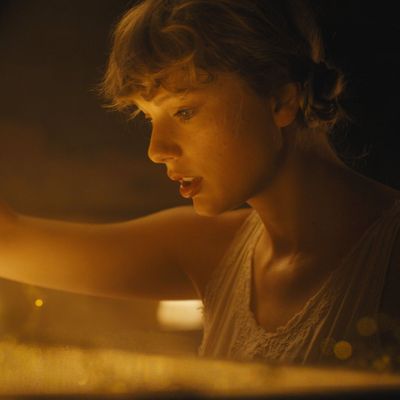
It’s hard to pin down folklore, Taylor Swift’s eighth album, recorded and surprise-released during quarantine. When news came out of the deep collaboration with the National’s Aaron Dessner that rooted this project, fans and critics assumed it would be something close to indie folk. Swift had dipped her feet in the water of that genre before, on Hunger Games soundtrack contribution “Safe & Sound” and Red tracks like “Sad, Beautiful, Tragic.” But the album, while her quietest yet, didn’t quite live up to that descriptor — because at the end of the day, Taylor Swift remains a pop songwriter with an innate sense for great pop melodies and music. It’s near-impossible for her to make “alternative” music because she reflects and defines the mainstream. The question of folklore’s genre means its influences branch out like an old oak tree in Swift’s woods: from her collaborators, to some of the year’s finest music, to folk performers old and new, to the prettiest and most delicate pop of the past five decades. Here are just 17 of the many albums you may hear flickers of in folklore.
The National, I Am Easy to Find
Swift’s odd-couple collaboration with Aaron Dessner didn’t come out of nowhere. For the release of her album Lover in 2019, she put two of the band’s songs on a playlist: “Rylan” and “Light Years,” both off the film companion album I Am Easy to Find. “Light Years” is definitely closer to folklore, built around Dessner’s piano and not much else. “She said that she’s a fan of the emotion that’s conveyed in our music,” Dessner told Vulture. “I know that the film [I Am Easy To Find] has really affected her, and she’s very much in love with that film and the record.” From there, backtrack to the dark Trouble Will Find Me, or find more of Dessner’s glitchy, experimental piano work on Big Red Machine, his collaboration with Bon Iver’s Justin Vernon.
Bon Iver, i,i
Speaking of: Start here for the “exile” collaborator’s catalog. For Emma, Forever Ago may be his sparse folk masterpiece, but i,i is Vernon’s most intimate work yet, the closest to folklore in spirit if not in sound. Tracks like “U (Man Like),” however, do feature some of the best examples of Vernon’s commanding baritone, which shines on “exile.” Swift is a Bon Iver fan too, according to Dessner — and even before folklore, a “Skinny Love” cover wouldn’t have sounded too far out of her field.
Bleachers, Strange Desire
You can hear every turn of Taylor Swift’s four-album run with Jack Antonoff somewhere in his own discography. While 1989 called to mind similarly big synth moments on Bleachers’ debut Strange Desire, folklore calls back to the quieter moments on that record. There’s a dark warmth on songs like “Wake Me” and “Who I Want You to Love” that feels akin to folklore contributions like “my tears ricochet” and “this is me trying.” And on “I’m Ready to Move On / Wild Heart Reprise,” Antonoff showed his own ability to revisit and reinterpret his own work, a theme throughout folklore. The “betty” harmonica, though, is all Steel Train.
Lana Del Rey, Norman Fucking Rockwell
As a producer, though, Antonoff’s been on a run of more intimate music over the past year, largely via his recent collaborations with Lana Del Rey. (Although, you’ll hear flickers of it on Chicks tracks like “My Best Friend’s Weddings” and “Everybody Loves You.”) Antonoff expands on the largely acoustic Norman Fucking Rockwell, with just enough strings to match the grandness of the occasion, on his later folklore tracks like “this is me trying” and “illicit affairs.”
Phoebe Bridgers, Punisher
Album cover similarities not discounted, Swift’s closest 2020 analog to folklore is Punisher, the second solo album by indie luminary Phoebe Bridgers. Closer to true indie folk than folklore, it’s another sparse, naturalistic, beautiful record by an unimpeachably good lyricist. “Garden Song” is for the cottagecore folklore fans, “Punisher” pairs well with pensive Taylor, “Moon Song” and “ICU” are two sides of Swiftian love and breakup anthems. No wonder Bridgers herself is a Swift fan.
Hayley Williams, Petals for Armor
For other examples of stars leaving their upbeat pop era for a darker sound, look to Paramore leader Hayley Williams’ debut solo album Petals for Armor. Percussion drives many of her tracks, making the quieter ones like “Leave It Alone” and “My Friend” recall the musical sketches that built the Dessner tracks on folklore. But at the end of the day, Williams’ anthems of resilience will satisfy those who loved hearing Swift say “fuck” on “mad woman,” one of her angriest songs to date.
Fiona Apple, Fetch the Bolt Cutters
Recorded fully under social isolation during the COVID-19 pandemic, folklore has become an intentional soundtrack to quarantine — a musical example of not just the quiet of our shared solitude, but the opportunity for reflection that comes with it. It takes the torch from Fiona Apple’s eight-years-in-the-making Fetch the Bolt Cutters, an unintentional quarantine soundtrack made under Apple’s own self-imposed isolation. Bolt Cutters sounds denser and harsher than folklore, but could appeal to fans of the record’s drum tracks; for Apple’s own take on folk, look back to 2012’s The Idler Wheel …
Mazzy Star, So Tonight That I Might See
Swift has been playing with some of the sounds on folklore since she released Lover last year — particularly the spacier, ethereal sounds on songs like “Lover.” And since Lover, critics have been tracing that sound back to Mazzy Star, who channeled rambling, folk-like songs through ‘90s dream-pop and shoegaze. (Dessner cited the band, too.) Songs like breakout hit “Fade Into You” and the epic title track have room to breathe, expanding and contracting over the course of minutes. Listening to them feels like floating, in the same way that songs like “mirrorball” and “this is me trying” do.
Kate Bush, The Sensual World
Along with Mazzy Star, some of the glimmering electronic-based moments of folklore, like the stunner “epiphany,” feel linked to art-pop legend Kate Bush (who, not to mention, pioneered reclusive music-making). The Sensual World remains her most polished, orchestrated album, after her masterpiece hit Hounds of Love. Not only does it turn to grander instrumentations, it leans further into the folk sounds Bush had been exploring at the time, particularly on Hounds of Love’s B-side The Ninth Wave. Not to mention, it’s some of Bush’s most humanistic songwriting, especially that gem of a closer “This Woman’s Work.”
Bob Dylan, The Freewheelin’ Bob Dylan
The closest folklore may come to folk is its debt to Bob Dylan, whose second album particularly inspired “betty,” Dessner told Vulture. And sure, there’s acoustic guitar and harmonica on tracks like “Blowin’ in the Wind,” but “betty” — the whole album, in fact — is more of a companion in writing. Swift said she blended “fantasy, history, and memory” on the album, with folklore truly being an overarching descriptor for her storytelling. Few musicians do the same better than folk icon Bob Dylan, who’s back on that track nearly 60 years later with his striking 39th studio album, Rough and Rowdy Ways.
Air, The Virgin Suicides (Original Motion Picture Score)
On her mood board of folklore’s dark film influences, Vulture’s Rachel Handler included Sofia Coppola’s adaptation of The Virgin Suicides, one of the least horrific movies on the list — but with one of the more haunting scores. French electronica duo Air created their score like an album, interpreting the uncomfortable late-’70s Americana of the story into 13 spare, ambient songs that convey the tragic isolation in the film. folklore’s darkest moments are no match for Air’s score, but there are moments of levity too, like the shining “Cemetary Party.”
Sufjan Stevens, Carrie & Lowell
Sufjan Stevens is a master of the balance between the natural and the celestial that Swift tried to strike on folklore. His last album, Carrie & Lowell, is one of his most intimate, recorded in response to the death of his mother (the titular Carrie) and returning to the acoustic folk sound that built his career. Like Swift, Stevens also has a gift for narrative, and works between memory and historical allusion on his music as well.
Sixpence None the Richer, Sixpence None the Richer
Over the past few years, musicians have admitted to drawing inspiration from previously derided ‘90s and ‘00s music, from Avril Lavigne to Sublime. Taylor Swift owes a similar debt to Sixpence None the Richer, who perfected the jangly guitar-pop of “last great american dynasty,” “august” and “betty” on their 1997 debut, especially singles “Kiss Me” and “There She Goes.” (The subliminal queerness in Leigh Nash’s decision to cover the latter and keep the pronouns intact cannot be understated.)
The Fray, The Fray
folklore may be the most piano-centric album by Swift, who seemed tethered to her acoustic guitar in her early years as a singer-songwriter. That nudges it into conversation with the ‘00s piano rock exemplified by The Fray. While folklore is largely darker and less forceful than The Fray, at the end of the day, it’s a person pouring out their heart in front of a piano (remember “How to Save a Life”?). Plus, listen to the bridge of “exile” and the chorus of “Never Say Never” back to back. Just trust me on this one.
Hippo Campus, Landmark
Lost amid the black-and-white cover and overall isolated feeling of folklore are the candylike, sunny melodies on songs like “august” and “betty.” Even the chorus of “seven” feels like a playground rhyme. Turn to Landmark, the debut album by the Minneapolis art school boys of Hippo Campus, for a necessary break from folklore’s quieter moments. The melodies are just as summery as folklore’s brightest moments, but the songs are as delicate as the album’s ballads.
Waxahatchee, American Weekend
One of the recent pinnacles of isolated indie folk came on Katie Crutchfield’s debut album as Waxahatchee, American Weekend. Recorded in her parents’ house with a guitar and not much else, it developed Crutchfield’s signature brand of self-scrutinizing songwriting, which drives this diaristic collection of songs. Fans of reverb Taylor (on “this is me trying”) may love it, with one important concession: While Swift’s music, especially folklore, sounds deliberately perfect, American Weekend revels in its imperfections, like good folk ought to.
The Hunger Games: Songs From District 12 and Beyond
Maybe Swift was dropping hints about her eventual woodsy turn as far back as 2012, when she contributed “Eyes Open” and the Civil Wars collab “Safe & Sound” to the soundtrack for the first Hunger Games. On the whole, it’s a spotty album: Heavier tracks like Kid Cudi’s contribution stand out, and Maroon 5’s attempt at folk just sounds silly. But the more hushed songs, from Neko Case’s elegant “Nothing to Remember” to the Pistol Annies’ harmonies on “Run Daddy Run,” are worth your time. (And while there’s nothing quite like it on folklore, Carolina Chocolate Drops’ “Daughter’s Lament” astonishes.) And “Safe & Sound” is a reminder of the rootsier direction Swift could’ve taken folklore in — a style she’s already proven capable of.


